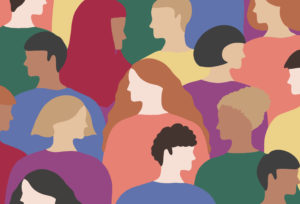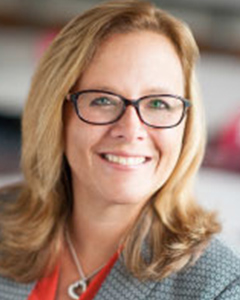Just about two weeks ago, our very large family grew just a little larger with the addition of our youngest family member, a betta fish named Cheese. Who knew this tiny addition had much to teach our family and my school?
Cheese is a frisky, colorful, active betta fish with a giant aquarium all to themself. Our 15-year-old, Kateri, and her best friend, Soph, made the decision to adopt two betta, respectively named Ham and Cheese, and gave their fish the pronouns they, them, and theirs. There was minimum fanfare with the adoption of Ham and Cheese. Kateri, Soph, and our youngest, Kieran, headed out to PetSmart, picked them up, and brought them home with a few accessories: a tiny water castle, leaf hammock, betta food. All along, Kateri had been sharing her choice to use they/them/their pronouns for her fish, Cheese, for at least a week prior, and honestly, it just seemed like a typical notion. I had not given it much thought or attention. We have many discussions in our diverse home around inclusivity, equity, racism, and biases.
And yet this was not a typical notion, nor something to be overlooked. Kateri had deliberate intentions for her actions. By giving Cheese they/them/their pronouns, she hoped to normalize her use of the pronouns, enabling her to practice with Cheese so it wouldn’t ever feel odd or forced when she encounters someone who prefers them. Kateri took it upon herself to create an opportunity where she could continue to evolve to be better for someone she has yet to meet. Kateri respectfully encourages everyone in our home to use the appropriate pronouns for Cheese and welcomes the conversations (even the difficult ones) around her choice. She gives grace when we forget, humbly admits when she makes a mistake, correcting herself gracefully as well, and because of this I do believe that Cheese feels safe and respected in their new home. As a family, we continue conversations about how it does take practice on what to say when we might misspeak, look for opportunities to be better, and reflect on where and why we are in our biases.
At Sarah Pyle Academy (SPA), my nontraditional—and quite amazing—program in Wilmington, DE, we have a very strategic plan to care for the overall health and well-being of our entire community. As a community, we have created a culture that is hyper-focused on preparing our students for life after high school in a safe, mentally healthy, voice-rich space. We are intentional in providing a safe space for all and evaluating what that means. We collect perception data to track how we are doing along the way, are deliberate in our professional development plan to address our needs, create space for all to share, and encourage our community to share their pronouns to help normalize them. Reflecting on Cheese and their opportunity felt uncomfortable. Like we missed something. We could be better. Had we truly specifically addressed gender biases at SPA?
Cheese provided us an opportunity to dig in more deeply and reflect on our own biases around gender and how that might impact our school community. Specifically, to consider what we have not yet provided for our school community—an opportunity to normalize without the pressure of disappointment. Admittedly, our community has fumbled our way through several anti-bias situations. We continue to look for professional development that fits our needs and are transparent about our journey. Maya Angelou says it best: When we know better, we do better. Creating opportunities to lean into to our schoolwide values by providing behaviors that support anti-bias is one way we all can do better.
And because of Cheese, we recognized we still have much work to do in creating intentional and deliberate activities and opportunities to continue to push our evolution forward in normalizing gender. We recognized that a big part of the work, a big part of continual anti-bias leadership, is recognizing the dissonance, the disequilibrium, the discomfort that can be evoked by looking our biases in the face and doing better. This is where the real work happens and needs to be encouraged to occur safely. Anti-bias work takes time, leadership, trusting relationships, and lots of deep conversations.
Why is this so important with all the work we are already doing? Well, while mental healthiness is a critical piece of all that we do, the data around our LGBTQ+ family increases the urgency for us to be more thoughtful and deliberate. Please take a moment to reflect on the following data gleaned from the 2020 National LGBTQ Survey:
- Forty percent of LGBTQ respondents seriously considered attempting suicide in the past 12 months, with more than half of transgender and nonbinary youth having seriously considered suicide (compared to 13 percent of non-LGBTQ youth).
- Sixty-eight percent of LGBTQ youth reported symptoms of generalized anxiety disorder in the past two weeks, including more than 3 in 4 transgender and nonbinary youth (compared to 29 percent of non-LGBTQ youth).
- Forty-eight percent of LGBTQ youth reported engaging in self-harm in the past 12 months, including over 60 percent of transgender and nonbinary youth.
- Forty-six percent of LGBTQ youth report they wanted psychological or emotional counseling from a mental health professional but were unable to receive it in the past 12 months.
- Ten percent of LGBTQ youth reported undergoing conversion therapy, with 78 percent reporting it occurred when they were under age 18.
- One in 3 LGBTQ youth reported that they had been physically threatened or harmed in their lifetime due to their LGBTQ identity.
- Sixty-one percent of transgender and nonbinary youth reported being prevented or discouraged from using a bathroom that corresponds with their gender identity.
- Eighty-six percent of LGBTQ youth said that recent politics have negatively impacted their well-being.
- Transgender and nonbinary youth who reported having pronouns respected by all or most people in their lives attempted suicide at half the rate of those who did not have their pronouns respected.
While all our children are in crisis and vulnerable, our LGBTQ community is especially vulnerable to bullying, harassment, and discrimination. In order to get the most out of our students, we need to not only meet them at their need level, but also demonstrate that we fundamentally respect them by demonstrating they are worth the work and effort of our continued evolution. And to practice not making them feel uncomfortable, different, less, unseen, unheard.

It can start with acknowledging and evaluating where we are as leaders before we can move the work into our schools and classrooms. We must reflect on our understanding of gender and how that might impact our decisions, leadership, intentions, and, ultimately, our community. Then we can begin to make more intentional and informed decisions about creating opportunities and access in addressing inequity and baises, specifically around gender. Commit to a first step of using nonbinary language—folks instead of ladies and gentlemen, friends instead of boys and girls.
I am fairly certain Cheese is relatively neutral about their pronouns, and for one I am eternally grateful for the opportunity Kateri and Cheese provided us. Join us during our NASSP Virtual Tour and see a few of the ways #SPAinspires strives to do just that—And long live Cheese!
“The true measure of any society can be found in how it treats its most vulnerable members.” —Mahatma Gandhi
This blog is part of NASSP’s Virtual Tour Series. Be sure to visit NASSP’s Facebook page on February 17 at 10:00 a.m. (ET) to participate in the live tour and join Kristina at 9:00 p.m. (ET) on February 21 for a Pau Hana, an informal virtual networking session to ask questions and keep the conversation going.

